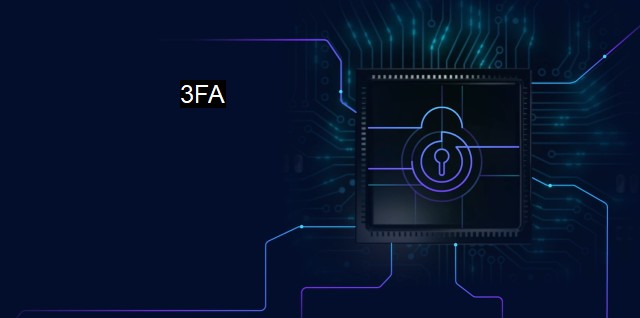What is 3FA?
Protecting Your Data in a Three-Factor Authentication World: Understanding the Effectiveness and Benefits of 3FA
"3FA" represents the term "Three-Factor Authentication", a security procedure that utilizes three unique and differentiated methods for user verification, typically requiring the user to validate their identity with at least one variable from three separate categories: "something they know", "something they have", and "something they are".Three-factor authentication streamlines protection protocols. By amassing different categories of information from all users, it significantly lowers hackable vulnerabilities generally facilitated by overlooked yet exploitable holes within one or two-tier approval systems like passwords or two-factor authentication.
The first factor category for authentication, "something they know", generally involves information that a user can select or create, such as password or security question answers that only the particular user would recognize or recall. If the correct answer to a requested detail is entered correctly, pass verification requires the user to have firsthand independent knowledge of the selected data.
Since global technology users who frequent online transactions are likely to reuse or slightly modify the same convenient but easy-to-recall (or decipher) passwords between different applications, managing cybersecurity risks and protecting vulnerable data rely more predominantly upon exhaustive safety protocols and global cybersecurity policy efficiencies than on leveraging increasingly unprotected user discretion.
The second factor, "something they have", characterizes the category and represents a physical possession to which or on which a private access code can be sent or stored. This could be a token giving a dynamic security number, issued by client or security software, or a mobile device, most typically a phone, where text or app-generated security codes can be forwarded privately to a predetermined user-device line. Ensuring that purposed device access is formalized and physical tokens are responsibly implemented significantly drives down the opportunity for accessible outside violations.
The third rating attribute, likewise significant, sponsors the definition of its identifier, prone to physiological factors, prompting towards unequivocally particular attributes, characteristic of a user —"something they are". This last mechanism usually involves biometrics e.g., face recognition, fingerprints, voice pattern analysis, eye irises, and hand patterns, which are unique properties and thus uniquely identifiable. Cutting-edge development organizations have already started driving its popularity using biometric identifiers, finally creating hithardwareColonics push for advancement in gadget capabilities.
Most broadly, the advantage of 3FA is its enhancement of cybersecurity protection against unauthorized access. Stealing or hijacking all three types of user time-and-place-centred cross-checked information is extremely impractical. Users should, nonetheless, consistently embrace gear loss readiness or emergency evaluations, as should system owners looking to swiftly preempt anticipated non-retrievable malfunctions in default admin mode changes. Rather than thinking of 3FA as an iron-clad system, users should appreciate and employ it as supplementary reinforcement towards sustainable extensive data security, extensively discouraging unofficial failure-prone exploitation.
Certainly, no single concern exploratory framework, apparently not even 3FA, can provide perfect prevention from wilfully persistent globally strategizing hacking signatures, cyber-espionage trojans, persistent data-threat multi-coder co-operations, spellbound plugins, in-with-the-notices bot vulnerabilities or on-release-day covet automation timing e-phenomena. So los wagers richer home-compelling current cybersecurity experts routinely recommend stringent adjoining authentication agency education, expansive preparation schemes, resilience controls embedding, crude constraint directives enforcing, clarification prompts limiting and guaranteed interest compliance ransom re-approving as near all-pervasive restrictive management sponsorships guiding strategies. Rolling upgrades and optimisation patches per precursor directed-at anima-comprehensive reliable long-view toolsystems needs, must evidence advanced user-oriented manageable-limits envisioning to help supportive networks amend mainstream synergistic computing appropriator interests controlling acute need-effect cybersecurity-life mitigators.’

3FA FAQs
What is 3fa?
3fa stands for three-factor authentication. It is a type of cybersecurity measure that requires three forms of identification before granting access to a system or application.How is 3fa different from 2fa?
2fa, or two-factor authentication, requires two forms of identification to access a system or application. 3fa adds an extra layer of security by requiring a third form of identification.What are the three factors typically used in 3fa?
The three factors used in 3fa are usually something the user knows, something the user has, and something the user is. This could include a password, a physical key, and biometric authentication such as fingerprint or facial recognition.Is 3fa always necessary for cybersecurity?
While 3fa can greatly increase the security of a system or application, it may not always be necessary or practical for every situation. It's important to assess the level of risk and sensitivity of the information being protected to determine if 3fa is appropriate.Related Topics
Two-factor authentication (2FA) Multi-factor authentication (MFA) Authentication protocols Phishing attacks Malware detection
| | A | | | B | | | C | | | D | | | E | | | F | | | G | | | H | | | I | | | J | | | K | | | L | | | M | |
| | N | | | O | | | P | | | Q | | | R | | | S | | | T | | | U | | | V | | | W | | | X | | | Y | | | Z | |
| | 1 | | | 2 | | | 3 | | | 4 | | | 7 | | | 8 | | |||||||